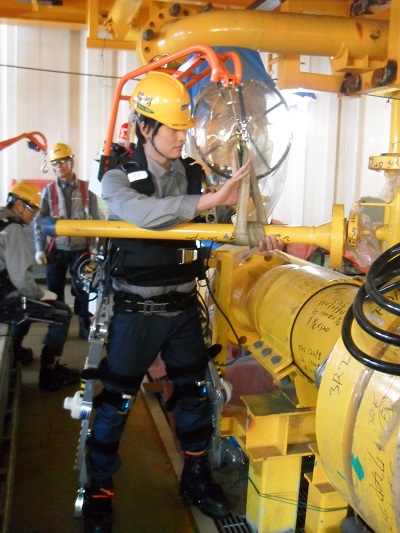On Shift With a Robot
Usually the insulation boxes used to line the tanks of LNG carriers are installed by three shipyard workers. Two lift and move the 75kg box a distance of around 5m; the third fastens it into position. On average, there are 5,000 such boxes to be installed for each tank, some on inclines, some on the ceiling. It’s a phenomenal task, even by shipyard standards.

As an operation standard, DSME strongly recommends its workers to use a crane or lifting devices when they handle components that weigh more than 20kg. The prototype robot can take the lifting strain of 30kg, so a 50kg object would weigh 20kg. If the object weighs less than the lifting capacity of the robot, it robot can support the whole weight while the worker just keeps it balanced.
The robot is composed of a backplate, legs and lifting device. It weighs 28 kilograms and is made of carbon, aluminum alloy and steel. It can be worn by anyone between 160cm (about 5 foot 2) and 185cm (6 foot) tall. The device is self-supporting, as it includes a frame that extends to the ground. The worker does not feel any of the weight. A system of hydraulic joints and electric motors running up the outside of the legs links to a backpack which powers and controls it.

Little effort is required to put the robot on. “When we use the lavatory, we take off the wearable robot because it is not convenient even though it is not impossible. We can put on and take off the wearable robot easily without the help of others.”

that matters most
Get the latest maritime news delivered to your inbox daily.
Chu says it could be up to five years before the prototype will be used for general ship production. He and his team are currently working on increasing motion speed and also lifting capacity which Chu wants to extend to 100kg.
In the longer term, he envisages various types of wearable robots in daily life as well as industry, the military and rehabilitation, but as an engineer for shipbuilding and marine engineering company, he has further shipbuilding applications on his mind. “Besides using the robot and automation technology we want to develop innovative, eco-friendly, automated products such as drone ships, unmanned offshore plants, underwater vehicles and more,” he says.
The opinions expressed herein are the author's and not necessarily those of The Maritime Executive.
